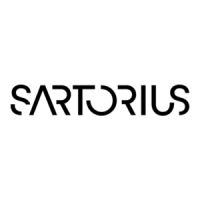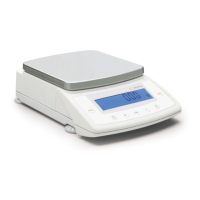Do you have a question about the Sartorius CPA623S and is the answer not in the manual?
Read instructions carefully before use to prevent equipment damage.
Ensure voltage compatibility, use RS-232 with caution, check pin assignments.
Avoid exposure to extreme temperatures, moisture, shocks, blows, or vibration.
Check equipment immediately for any external damage after unpacking.
Choose a location free from heat, drafts, vibrations, and excessive moisture.
Acclimate balance to room temperature for 2 hours before connecting AC power.
Steps for installing the CPA2P model, including component placement in the chamber.
Steps for installing the CPA2P-F, accommodating filters or standard pans.
Instructions for positioning and securing the analytical draft shield on the balance.
Component placement order for triangular weighing pan shapes.
Component placement order for round weighing pan shapes.
Procedure for connecting specific balance models to their electronics box.
Steps for placing and securing the 3-sided draft shield on the balance.
Placing components for balances with rectangular pans and capacities up to 10 kg.
Installing the weighing pan for balances with rectangular pans and capacities over 10 kg.
Steps to connect specific models to AC power via the electronics box.
Steps to connect other balances with capacities up to 10 kg to AC power.
Guidelines for using country-specific power cords with the AC adapter.
Connecting balances with capacities over 10 kg to AC power.
Safety notes on plug-in AC adapters, grounding, and FCC compliance.
Ensure balance is unplugged from AC power before connecting/disconnecting peripherals.
Required time for balance to warm up for accurate results after power connection or outage.
Securing the balance using a chain or lock to the rear panel lug for theft prevention.
Identifies and explains the functions of all keys, symbols, and display segments on the balance.
Initial steps including power-on, display test, and tare function.
Includes switching off the balance and specific weighing procedures for CPA2P-F.
Procedure for printing the current balance parameter settings from the Setup menu.
Configuring measurement environment parameters for ISO/GLP records and adapting display.
Describes key operations for inputting IDs, time, date, and saving settings.
Explains the use of F and CF keys for starting, toggling, and ending application programs.
Program to weigh components up to a defined total weight, with data storage features.
Weighing up to 99 components, automatic storage and printout, clearing memory.
Steps to set parameters for net-total formulation, including automatic printout.
Program to determine the number of parts by weighing a reference sample quantity.
Minimum load, setting reference quantity, configuring resolution, and output options.
Automatic updating for counting accuracy optimization; can be activated/deactivated.
Using a reference balance for higher precision in counting large parts.
Program to obtain weight readouts in percent relative to a reference weight.
Setting reference percentage, storage parameter, and decimal places.
Steps to set parameters for percentage weighing program and configure decimal places.
Program to determine weights of unstable samples by averaging multiple readings.
Manual/automatic start, minimum load, animal activity settings, and averaging operations.
Steps to set parameters for animal weighing program and select start mode.
Program to switch the display between two different weight units via Setup menu.
How to generate printouts including weights, values, and identification codes.
Describes printout features like line format, application parameters, and ISO/GLP compliance.
Examples of printouts with and without data ID codes, showing different data types.
Details on automatic printing of weight readouts and related features.
Parameters for generating ISO/GLP compliant printouts, including headers and footers.
Describes menu codes for enabling ISO/GLP compliant records and line formats.
Details on the balance's interface port for computer connection, including features.
Describes factory default settings for transmission rate, parity, handshake, and mode.
Preparation steps and how to identify non-verified digits on the printout.
Describes output formats with 16 characters, special codes, and error codes for data transmission.
Details on output format with 22 characters, including ID codes and unit symbols.
Explanation of special codes, error codes, and meanings of ID code characters.
Format specifications for sending control commands to the balance via the interface port.
Describes command characters for various balance functions and modes.
Parameters for synchronization, matching settings between balance and connected device.
Describes hardware and software handshake modes for data communication.
Managing software handshake, print commands, and automatic data output.
Information regarding requirements for output speeds faster than 10 Hz.
Detailed pin assignments for female and male connectors, and warnings for RS-232 cable use.
Common display errors, their causes, and solutions for troubleshooting balance issues.
Steps to prepare CPA2P models for transport, including removing parts and securing doors.
Steps to prepare CPA2P-F models for transport, including filter pan removal.
General guidance on service, repairs, cautions, and cleaning procedures for the balance.
Specific instructions for cleaning stainless steel parts, including the weighing pan.
Instructions for cleaning the weighing chamber and draft shield, and removing parts.
Procedures for safety inspection, including power disconnection and contacting service.
General specifications for CPA2P and CPA2P-F models, including weighing ranges and dimensions.
Lists optional accessories like data printers and reflective remote displays with order numbers.
Details external rechargeable battery packs and carrying cases for different balance models.
Details additional accessories such as software, density kits, weighing pans, and calibration weights.
Lists industrial AC adapters and analytical draft shield chambers with part numbers.
Lists draft shield covers, data cables for PC connection, and adapters.
Details remote controls, below-balance weighing hangers, and dust covers.
Explains weighing instrument directives, EC verification services, and subsequent verifications.
Describes EC verification services for legal metrology, offered by authorized technicians.
Identifies various plates and markings on BC BL 100, BD BL 100, BD BL 200 models.
Identifies various plates and markings on the BF BL 500 model.
Explains the meaning of symbols (K, M, S, MD, T) used on the balance plates.
Read instructions carefully before use to prevent equipment damage.
Ensure voltage compatibility, use RS-232 with caution, check pin assignments.
Avoid exposure to extreme temperatures, moisture, shocks, blows, or vibration.
Check equipment immediately for any external damage after unpacking.
Choose a location free from heat, drafts, vibrations, and excessive moisture.
Acclimate balance to room temperature for 2 hours before connecting AC power.
Steps for installing the CPA2P model, including component placement in the chamber.
Steps for installing the CPA2P-F, accommodating filters or standard pans.
Instructions for positioning and securing the analytical draft shield on the balance.
Component placement order for triangular weighing pan shapes.
Component placement order for round weighing pan shapes.
Procedure for connecting specific balance models to their electronics box.
Steps for placing and securing the 3-sided draft shield on the balance.
Placing components for balances with rectangular pans and capacities up to 10 kg.
Installing the weighing pan for balances with rectangular pans and capacities over 10 kg.
Steps to connect specific models to AC power via the electronics box.
Steps to connect other balances with capacities up to 10 kg to AC power.
Guidelines for using country-specific power cords with the AC adapter.
Connecting balances with capacities over 10 kg to AC power.
Safety notes on plug-in AC adapters, grounding, and FCC compliance.
Ensure balance is unplugged from AC power before connecting/disconnecting peripherals.
Required time for balance to warm up for accurate results after power connection or outage.
Securing the balance using a chain or lock to the rear panel lug for theft prevention.
Identifies and explains the functions of all keys, symbols, and display segments on the balance.
Initial steps including power-on, display test, and tare function.
Includes switching off the balance and specific weighing procedures for CPA2P-F.
Procedure for printing the current balance parameter settings from the Setup menu.
Configuring measurement environment parameters for ISO/GLP records and adapting display.
Describes key operations for inputting IDs, time, date, and saving settings.
Explains the use of F and CF keys for starting, toggling, and ending application programs.
Program to weigh components up to a defined total weight, with data storage features.
Weighing up to 99 components, automatic storage and printout, clearing memory.
Steps to set parameters for net-total formulation, including automatic printout.
Program to determine the number of parts by weighing a reference sample quantity.
Minimum load, setting reference quantity, configuring resolution, and output options.
Automatic updating for counting accuracy optimization; can be activated/deactivated.
Using a reference balance for higher precision in counting large parts.
Program to obtain weight readouts in percent relative to a reference weight.
Setting reference percentage, storage parameter, and decimal places.
Steps to set parameters for percentage weighing program and configure decimal places.
Program to determine weights of unstable samples by averaging multiple readings.
Manual/automatic start, minimum load, animal activity settings, and averaging operations.
Steps to set parameters for animal weighing program and select start mode.
Program to switch the display between two different weight units via Setup menu.
How to generate printouts including weights, values, and identification codes.
Describes printout features like line format, application parameters, and ISO/GLP compliance.
Examples of printouts with and without data ID codes, showing different data types.
Details on automatic printing of weight readouts and related features.
Parameters for generating ISO/GLP compliant printouts, including headers and footers.
Describes menu codes for enabling ISO/GLP compliant records and line formats.
Details on the balance's interface port for computer connection, including features.
Describes factory default settings for transmission rate, parity, handshake, and mode.
Preparation steps and how to identify non-verified digits on the printout.
Describes output formats with 16 characters, special codes, and error codes for data transmission.
Details on output format with 22 characters, including ID codes and unit symbols.
Explanation of special codes, error codes, and meanings of ID code characters.
Format specifications for sending control commands to the balance via the interface port.
Describes command characters for various balance functions and modes.
Parameters for synchronization, matching settings between balance and connected device.
Describes hardware and software handshake modes for data communication.
Managing software handshake, print commands, and automatic data output.
Information regarding requirements for output speeds faster than 10 Hz.
Detailed pin assignments for female and male connectors, and warnings for RS-232 cable use.
Common display errors, their causes, and solutions for troubleshooting balance issues.
Steps to prepare CPA2P models for transport, including removing parts and securing doors.
Steps to prepare CPA2P-F models for transport, including filter pan removal.
General guidance on service, repairs, cautions, and cleaning procedures for the balance.
Specific instructions for cleaning stainless steel parts, including the weighing pan.
Instructions for cleaning the weighing chamber and draft shield, and removing parts.
Procedures for safety inspection, including power disconnection and contacting service.
General specifications for CPA2P and CPA2P-F models, including weighing ranges and dimensions.
Lists optional accessories like data printers and reflective remote displays with order numbers.
Details external rechargeable battery packs and carrying cases for different balance models.
Details additional accessories such as software, density kits, weighing pans, and calibration weights.
Lists industrial AC adapters and analytical draft shield chambers with part numbers.
Lists draft shield covers, data cables for PC connection, and adapters.
Details remote controls, below-balance weighing hangers, and dust covers.
Explains weighing instrument directives, EC verification services, and subsequent verifications.
Describes EC verification services for legal metrology, offered by authorized technicians.
Identifies various plates and markings on BC BL 100, BD BL 100, BD BL 200 models.
Identifies various plates and markings on the BF BL 500 model.
Explains the meaning of symbols (K, M, S, MD, T) used on the balance plates.











